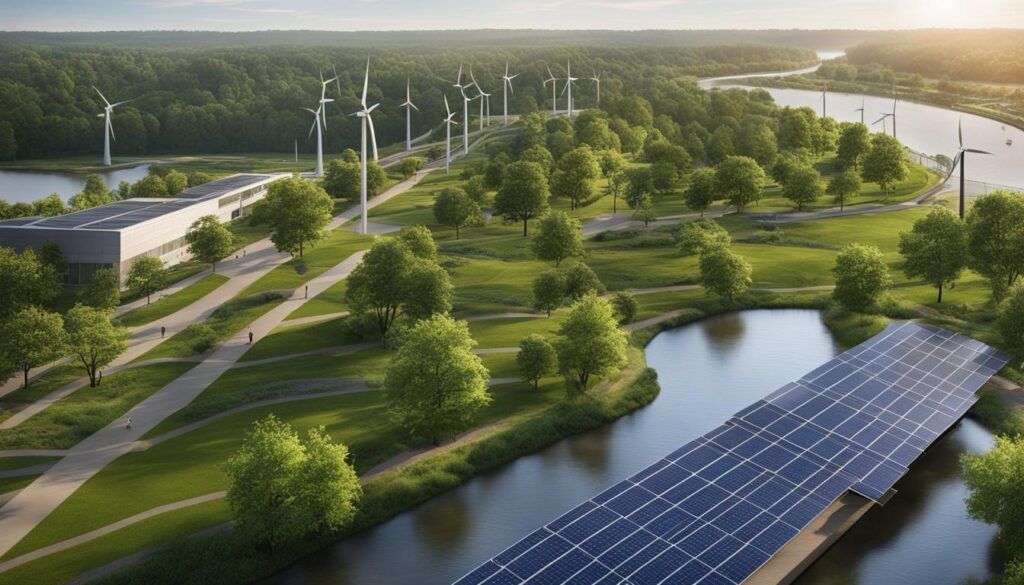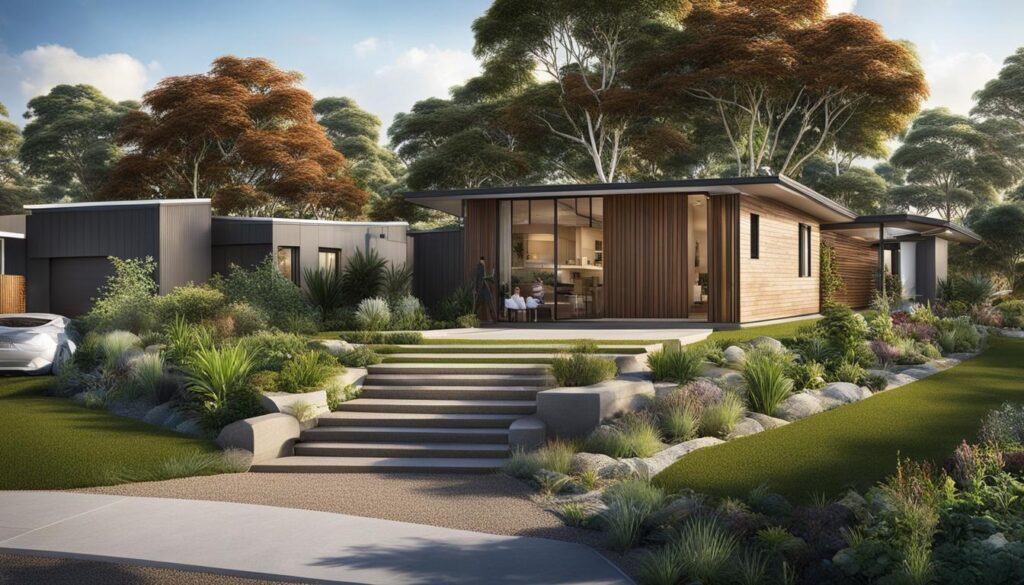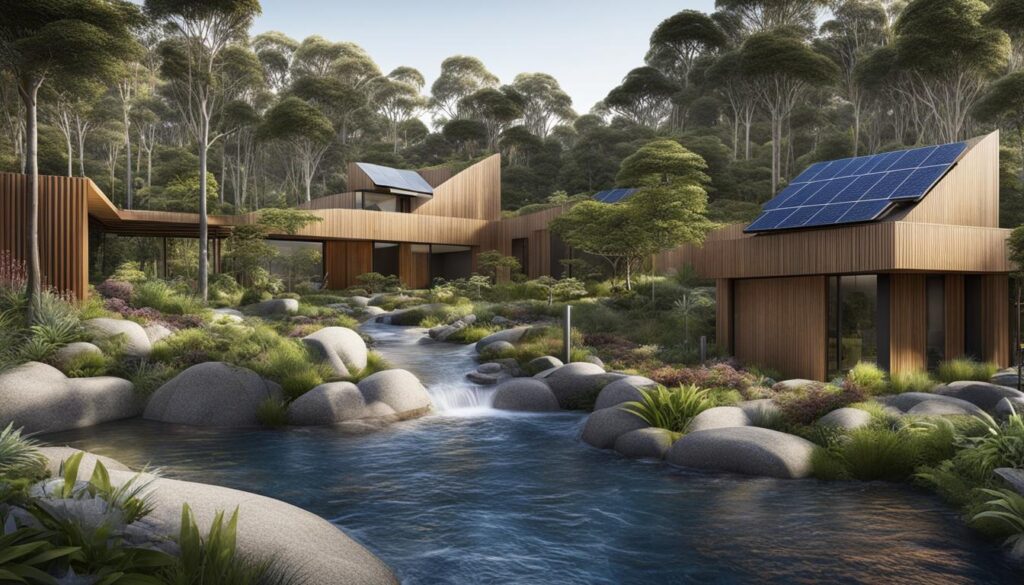Welcome to our article where we delve into the world of environmentally sustainable design (ESD) in the Mount Alexander Shire Council. As a council, we are dedicated to creating a sustainable and vibrant future for our community. By adopting a Council Plan for the years 2021-2025, we aim to work together towards a healthier and more connected shire.
Recognizing the traditional custodians of the land, the Dja Dja Wurrung and Taungurung peoples, our plan emphasizes the importance of community engagement and the preservation of our natural environment. Through sustainable architecture and green building practices, we strive to protect our shire from the threats of climate change.
Key Takeaways
- Mount Alexander Shire Council focuses on creating a sustainable and vibrant future.
- Community engagement and environmental preservation are at the forefront of our Council Plan.
- Sustainable architecture and green building practices are essential for climate change resilience.
- We value the traditional custodians of the land, the Dja Dja Wurrung and Taungurung peoples.
- Our goal is to work together towards a healthier and more connected shire.
Community Vision for a Sustainable Future
The Mount Alexander Shire Council’s Community Vision for 2021-2031 reflects the shared desire of our community for a sustainable and vibrant future. We recognize the importance of protecting the natural beauty of the Djaara Country and prioritizing environmentally sustainable development (ESD) to mitigate the impact of climate change. Our vision celebrates a connected and inclusive community that values social and creative pursuits, while ensuring access to essential services and housing.
By integrating environmental design solutions and eco-friendly building practices, we aim to create a sustainable built environment that harmonizes with the natural landscape. Our commitment to sustainable construction aligns with our goal of promoting a resilient and growing local economy. Through high-quality infrastructure and sustainable development projects, we strive to enhance the overall livability and attractiveness of Mount Alexander Shire.
We believe that by embracing sustainable architecture and green building practices, we can create a community that thrives in harmony with nature, while also ensuring that future generations can enjoy the richness and beauty of our shire.
The Three Pillars of our Community Vision
- Create a connected and inclusive community: We aim to foster strong community ties and promote social cohesion, while providing equal opportunities for all residents to participate in community life.
- Protect the natural environment: Our commitment to environmental sustainability includes preserving the unique natural features of our shire and promoting biodiversity conservation.
- Foster a resilient and growing local economy: We strive to support local businesses, attract new investment, and create employment opportunities that are aligned with sustainable development principles.
By aligning our strategic direction with the Community Vision, we are confident in our ability to create a sustainable and prosperous future for Mount Alexander Shire.
| Pillar | Key Objectives |
|---|---|
| Create a connected and inclusive community | – Enhance community engagement and participation – Improve access to essential services and facilities – Promote social inclusion and diversity |
| Protect the natural environment | – Preserve and enhance natural landscapes and ecosystems – Promote sustainable land management practices – Mitigate the impact of climate change |
| Foster a resilient and growing local economy | – Support local businesses and entrepreneurship – Attract new investment and job opportunities – Encourage sustainable and innovative industries |
Pillars of the Council’s Plan
The Mount Alexander Shire Council’s Plan for 2021-2025 is built upon four key pillars that guide its strategic direction and objectives. These pillars encompass a wide range of initiatives aimed at creating a sustainable and vibrant shire.
Creating a Connected and Inclusive Community
The first pillar focuses on fostering a sense of community and inclusivity within the shire. This involves promoting active community engagement, enhancing social connections, and ensuring that everyone has access to essential services and opportunities for personal and collective growth.
Protecting the Natural Environment
The second pillar highlights the council’s commitment to protecting the natural environment. This includes initiatives such as preserving green spaces, biodiversity conservation, and promoting sustainable land use practices. The council also aims to mitigate the effects of climate change through the implementation of green infrastructure and environmentally conscious policies.
Fostering a Resilient and Growing Local Economy
The third pillar recognizes the importance of a resilient and growing local economy. The council seeks to support local businesses, attract new investments, and create employment opportunities that align with sustainable development principles. By fostering economic growth, the council aims to enhance the overall well-being and livability of the shire.
Promoting High-Quality Infrastructure
The final pillar emphasizes the importance of high-quality infrastructure. This includes the development and maintenance of sustainable and functional public amenities, transportation systems, and utilities. The council aims to ensure that infrastructure projects align with environmentally friendly practices and contribute to the overall sustainability of the shire.

| Pillar | Key Focus Areas |
|---|---|
| Creating a Connected and Inclusive Community | – Promoting community engagement – Enhancing social connections – Access to essential services and opportunities |
| Protecting the Natural Environment | – Preserving green spaces – Biodiversity conservation – Sustainable land use practices |
| Fostering a Resilient and Growing Local Economy | – Supporting local businesses – Attracting investments – Creating employment opportunities |
| Promoting High-Quality Infrastructure | – Sustainable and functional amenities – Transportation systems – Utilities |
Assessing Housing and Neighbourhood Character
In our ongoing efforts to promote environmentally sustainable design and construction practices, we are currently engaged in the development of the Housing and Neighbourhood Character Strategy for Castlemaine, Campbells Creek, and Chewton. This strategy aims to guide future residential development by addressing the changing housing needs of our community and ensuring that new housing is provided in the right locations.
As part of this strategy, we recognize the importance of preserving the unique character and heritage values of our neighborhoods. We understand that sustainable architecture and green building practices play a crucial role in not only protecting our environment but also creating vibrant and livable communities. Therefore, our design guidelines for future development emphasize environmental sustainability, neighborhood character, and heritage values.
Design Guidelines Highlights
- Promotion of sustainable architecture and environmentally sustainable design principles
- Use of green building practices and sustainable construction materials
- Integration of energy-efficient features and renewable energy systems
- Incorporation of landscaping and green spaces to enhance the overall aesthetics and environmental quality
- Consideration of neighborhood scale, building setbacks, and building heights to maintain the existing streetscape and character
“Sustainable architecture is not just about creating beautiful buildings; it’s about creating a sustainable and resilient future for our community.”
By assessing and addressing housing and neighborhood character, we aim to strike a balance between meeting the needs of our growing population while preserving the unique charm and identity of our communities. Through the implementation of sustainable design and construction practices, we believe that we can create a built environment that respects our natural surroundings and enhances the quality of life for all residents.
| Table: Benefits of Environmentally Sustainable Design |
|---|
| Reduced energy consumption and greenhouse gas emissions |
| Improved indoor air quality and occupant well-being |
| Lower operational and maintenance costs for homeowners |
| Enhanced resilience to climate change and natural disasters |
| Preservation of natural resources and biodiversity |
Together, we can build a sustainable future for our community, one that embraces environmentally sustainable design and construction practices and promotes the well-being of both current and future generations.
Issues and Opportunities in Housing and Neighbourhood Character
The development of the Housing and Neighbourhood Character Strategy for Castlemaine, Campbells Creek, and Chewton presents a range of challenges and opportunities in terms of sustainable construction, eco-friendly building, and green infrastructure. By addressing these issues, we can create a sustainable and vibrant community that meets the changing needs of residents while preserving the unique character and natural environment of the shire.
Planning Policy and Environmental Concerns
One of the key considerations in residential development is ensuring that planning policies align with sustainable construction practices and eco-friendly building principles. This involves creating guidelines that promote energy efficiency, waste reduction, and the use of sustainable materials. Additionally, it is crucial to address environmental concerns such as flooding and bushfire risks. By integrating these considerations into the Housing and Neighbourhood Character Strategy, we can mitigate potential environmental impacts and create resilient, climate-responsive communities.
Preserving the Natural Environment
The preservation of the natural environment is paramount in sustainable development. The Housing and Neighbourhood Character Strategy must identify areas of ecological significance that should be protected from development. This includes prioritizing the preservation of vegetation, waterways, and biodiversity. By incorporating green infrastructure, such as parks, urban forests, and green roofs, we can enhance the quality of the built environment while providing valuable ecosystem services and promoting biodiversity.
Land Use Conflict and Contaminated Land
Residential development must also address potential land use conflicts and the remediation of contaminated sites. Careful consideration should be given to the compatibility of different land uses to minimize conflicts, such as locating residential areas away from industrial zones or noise-sensitive areas. Additionally, contaminated land should be properly assessed and remediated to ensure the safety and well-being of future residents. By managing land use conflicts and contaminated land effectively, we can create harmonious and healthy neighborhoods.
| Issues | Opportunities |
|---|---|
| Planning policy alignment | Promote sustainable construction and eco-friendly building practices |
| Environmental concerns | Address flooding and bushfire risks through resilient design |
| Preserving the natural environment | Integrate green infrastructure to enhance biodiversity and ecosystem services |
| Land use conflict | Minimize conflicts by careful land use planning |
| Contaminated land | Assess and remediate contaminated sites for safe residential development |
Population, Households, and Housing
The population of Castlemaine, Campbells Creek, and Chewton is projected to experience significant growth in the coming decades. As the region becomes increasingly attractive for residents seeking a sustainable and connected community, it is essential to plan for housing that meets their changing needs. Our Housing and Neighbourhood Character Strategy takes into account population forecasts, household demographics, and the availability of housing to ensure a diverse range of options for residents.
By incorporating sustainable development projects and environmentally sustainable design principles, we aim to create housing that not only meets the needs of the community but also minimizes its impact on the environment. This includes promoting the use of sustainable building materials, implementing energy-efficient measures, and incorporating green infrastructure into new housing developments.
Our strategy recognizes the importance of providing housing options that are both affordable and sustainable. We are committed to creating smaller sustainable houses that are accessible to a wide range of households, including singles, couples, families, and older adults. By utilizing environmentally sustainable design principles, we can ensure that these housing options are energy-efficient, resource-efficient, and designed with the wellbeing of residents and the planet in mind.

As the population grows, it is vital to strike a balance between meeting housing demand and preserving the unique character and natural beauty of the shire. Our Housing and Neighbourhood Character Strategy considers factors such as land availability, heritage values, and environmental considerations to guide future residential development. By carefully planning and integrating sustainable practices into our housing initiatives, we can create a vibrant and sustainable community for current and future residents.
Land Supply and Demand
The availability of land for residential development plays a crucial role in meeting the housing needs of a growing population. The Mount Alexander Shire Council, through its Housing and Neighbourhood Character Strategy, assesses the current land supply and future demand for housing in the shire. By understanding these factors, the council can ensure a balanced approach that addresses the need for additional housing while preserving the environmental and heritage values of the area.
To determine the land supply, the council evaluates the availability of land in primary townships within the shire. This assessment considers factors such as vacant lots, brownfield sites, and potential land for rezoning. By identifying suitable land for development, the council can effectively plan for sustainable construction and housing projects that align with the community’s needs.
Simultaneously, the council also reviews the projected demand for housing in the Mount Alexander Shire. This analysis takes into account population forecasts, household demographics, and housing preferences. By understanding the future demand, the council can anticipate the types of housing required, such as sustainable and affordable options, to accommodate the diverse needs of current and future residents.
| Land Supply | Land Demand |
|---|---|
| Assessment of available land in primary townships | Review of population forecasts and household demographics |
| Evaluation of vacant lots, brownfield sites, and rezoning potential | Anticipation of housing preferences and needs |
| Identification of suitable land for sustainable construction and housing projects | Alignment of housing options with community requirements |
The Housing and Neighbourhood Character Strategy aims to strike a balance between the supply and demand of land, ensuring sustainable development practices and green infrastructure are incorporated into future housing projects. By prioritizing the preservation of the natural environment, the council can create a sustainable and vibrant community that meets the housing needs of its residents while safeguarding the unique character of the Mount Alexander Shire.
Key Points:
- The council assesses the availability of land in primary townships for residential development.
- The Housing and Neighbourhood Character Strategy reviews the projected demand for housing.
- Identification of suitable land for sustainable construction and housing projects is a priority.
- The strategy aims to strike a balance between land supply and demand while preserving the natural environment.
Conclusion
In conclusion, we, at the Mount Alexander Shire Council, are deeply committed to promoting sustainable architecture, construction, and development projects. Our Council Plan for 2021-2025, in conjunction with the Housing and Neighbourhood Character Strategy, sets a roadmap for creating a connected and inclusive community while prioritizing the preservation of our natural environment.
By embracing environmentally sustainable design principles, we strive to foster a resilient and growing local economy, all while preserving the unique heritage and character of Mount Alexander Shire. Through the implementation of green building practices and the use of sustainable construction materials, we aim to create a greener and more sustainable future for our community.
Our goal is to ensure that our shire thrives both economically and environmentally. We recognize the importance of sustainable development projects that not only meet the changing needs of our residents but also contribute to the overall well-being of our community. By working together, we can build a vibrant and sustainable future for Mount Alexander Shire.
FAQ
What is the Council Plan for Mount Alexander Shire Council?
The Council Plan is a strategic document that guides the Council’s priorities and objectives for the years 2021-2025. It focuses on working together for a healthy and connected shire, emphasizing community engagement, sustainability, and a vibrant future.
What is the Community Vision for Mount Alexander Shire Council?
The Community Vision highlights the importance of a connected and inclusive community in Mount Alexander Shire. It emphasizes the value of the natural environment and the need for environmentally sustainable development to protect against climate change. The vision sets the foundation for the Council’s strategic direction and objectives.
What are the pillars of the Council’s Plan?
The Council’s Plan is guided by four key pillars: creating a connected and inclusive community, protecting the natural environment, fostering a resilient and growing local economy, and promoting high-quality infrastructure. These pillars aim to achieve a sustainable and vibrant shire through various initiatives and projects.
What is the Housing and Neighbourhood Character Strategy?
The Housing and Neighbourhood Character Strategy is being developed to guide future residential development in Castlemaine, Campbells Creek, and Chewton. It aims to address the changing housing needs of the community and ensure that new housing is provided in appropriate locations. The strategy considers factors such as neighbourhood character, heritage values, and environmental sustainability.
What factors are considered in the Housing and Neighbourhood Character Strategy?
The Issues and Opportunities Paper for the Housing and Neighbourhood Character Strategy addresses various factors, including planning policy, environmental concerns such as flooding and bushfire, the natural environment, land use conflict, and contaminated land. It also examines specific areas for residential development, such as Happy Valley and strategic opportunity sites.
How does the Housing and Neighbourhood Character Strategy consider population growth?
The Housing and Neighbourhood Character Strategy considers population forecasts, household demographics, and the availability of housing. It aims to ensure a diverse range of housing options, including smaller sustainable houses and environmentally sustainable design principles, to meet the changing needs of residents.
How does the Housing and Neighbourhood Character Strategy assess land supply and demand?
The Housing and Neighbourhood Character Strategy examines the supply and demand of land for residential development. It reviews the availability of land in primary townships and projects the demand for housing. The strategy aims to balance the need for additional housing with the preservation of environmental and heritage values.
What is the goal of Mount Alexander Shire Council in terms of sustainable development?
Mount Alexander Shire Council is committed to environmentally sustainable design and development. Through the Council Plan and the Housing and Neighbourhood Character Strategy, the council aims to create a connected and inclusive community that values the natural environment. It prioritizes sustainable architecture, construction, and development projects to work towards a greener future for the shire.
Source Links
- https://hdp-au-prod-app-mtalex-shape-files.s3.ap-southeast-2.amazonaws.com/2016/6269/8062/Issues__Opportunities_paper_-_Housing_and_Neighbourhood_Character_Strategy_Castlemaine_Campbells_CReek_and_Chewton_-_July_2022.pdf
- https://www.mountalexander.vic.gov.au/files/assets/public/files/3.-council/about-council/community-vision-and-council-plan/mount-alexander-shire-council-plan-2021-2025-digital-october-2021.pdf
- https://au.linkedin.com/in/melanie-marshall-72ab4826
